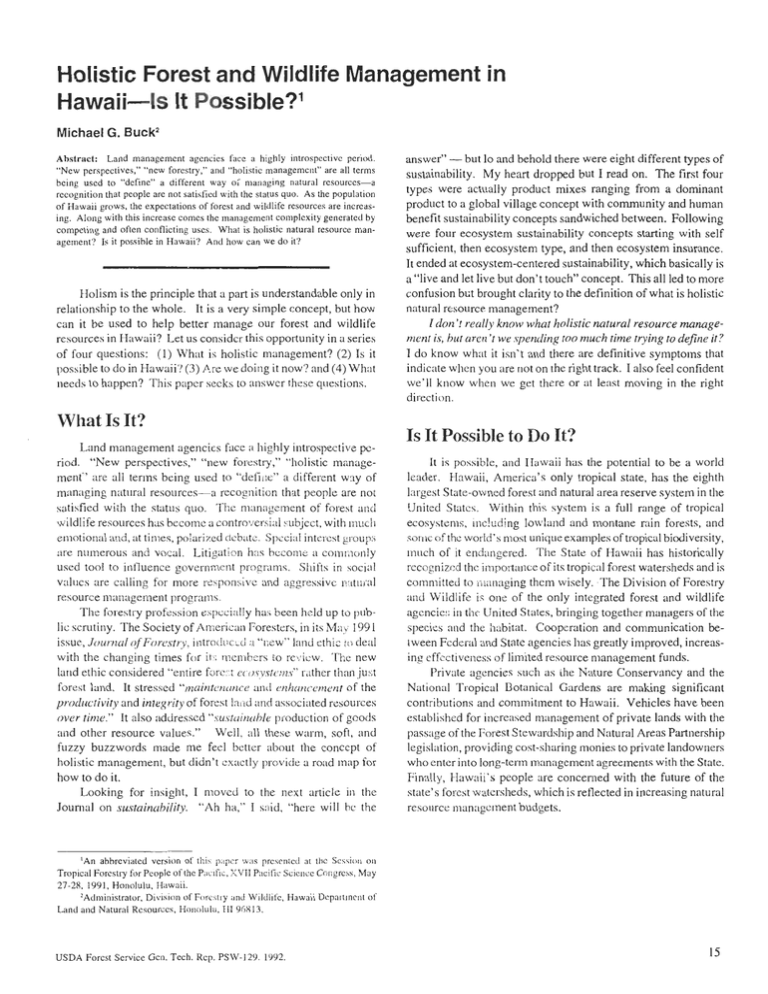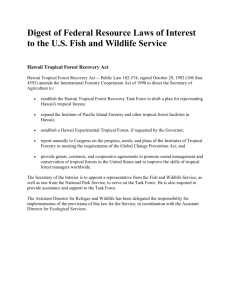Document 11232180
advertisement

Holistic Forest and Wildlife Management in Hawaii-Is It P~ssible?~ Michael G. Buck2 Abstract: Land management agencies face a highly introspective period. "New perspectives," "new forestry," and "holistic management" are all terms being used to "define" a different way of managing natural resources-a recognition that people are not satisfied with the status quo. As the population of Hawaii grows, the expectations of forest and wildlife resources are increasing. Along with this increase comes the management complexity generated by competing and often conflicting uses. What is holistic natural resource management? Is it possible in Hawaii? And how can we do it? Holism is the principle that a part is understandable only in relationship to the whole. It is a very simple concept, but how can it be used to help better manage our forest and wildlife resources in Hawaii? Let us consider this opportunity in a series of four questions: (1) What is holistic management? (2) Is it possible to do in Hawaii? (3) Are we doing it now? and (4) What needs to happen? This paper seeks to answer these questions. What Is It? Land management agencies face a highly introspective period. "New perspectives," "new forestry," "holistic management" are all terms being used to "define" a different way of managing natural resources-a recognition that people are not satisfied with the status quo. The management of forest and wildlife resources has become a controversial subject, with much emotional and, at times, polarized debate. Special interest groups are numerous and vocal. Litigation has become a commonly used tool to influence government programs. Shifts in social values are calling for more responsive and aggressive natural resource management programs. The forestry profession especially has been held up to public scrutiny. The Society of American Foresters, in its May 1991 issue, Journal of Forestry, introduced a "new" land ethic to deal with the changing times for its members to review. The new land ethic considered "entire forest ecosy¥stemsrather than just forest land. It stressed "maintenance and enhancement of the productivity and integrity of forest land and associated resources over time" It also addressed "sustainable production of goods and other resource values." Well, all these warm, soft, and fuzzy buzzwords made me feel better about the concept of holistic management, but didn't exactly provide a road map for how to do it. Looking for insight, I moved to the next article in the Journal on sustainability. "Ah ha," I said, "here will be the A n abbreviated version of this paper was presented at the Session on Tropical Forestry for People of the Pacific, XVII Pacific Science Congreiis, May 27-28, 1991, Honolulu, Hawaii. ^Administrator,Division of Forestry and Wildlife, Hawaii Department of Land and Natural Resources, Honolulu, HI 96813. USDA Forest Service Gen. Tech. Rep. PSW-129. 1992. answer" -but lo and behold there were eight different types of sustainability. My heart dropped but I read on. The first four types were actually product mixes ranging from a dominant product to a global village concept with community and human benefit sustainability concepts sandwiched between. Following were four ecosystem sustainability concepts starting with self sufficient, then ecosystem type, and then ecosystem insurance. It ended at ecosystem-centered sustainability, which basically is a "live and let live but don't touch" concept. This all led to more confusion but brought clarity to the definition of what is holistic natural resource management? I don't really know what holistic natural resource management is, but aren't we spending too much time trying to define it? I do know what it isn't and there are definitive symptoms that indicate when you are not on the right track. I also feel confident we'll know when we get there or at least moving in the right direction. Is It Possible to Do It? It is possible, and Hawaii has the potential to be a world leader. Hawaii, America's only tropical state, has the eighth largest State-owned forest and natural area reserve system in the United States. Within this system is a full range of tropical ecosystems, including lowland and montane rain forests, and some of the world's most unique examples of tropical biodiversity, much of it endangered. The State of Hawaii has historically recognized the importance of its tropical forest watersheds and is committed to managing them wisely. The Division of Forestry and Wildlife is one of the only integrated forest and wildlife agencies in the United States, bringing together managers of the species and the habitat. Cooperation and communication between Federal and State agencies has greatly improved, increasing effectiveness of limited resource management funds. Private agencies such as the Nature Conservancy and the National Tropical Botanical Gardens are making significant contributions and commitment to Hawaii. Vehicles have been established for increased management of private lands with the passage of the Forest Stewardship and Natural Areas Partnership legislation, providing cost-sharing monies to private landowners who enter into long-term management agreements with the State. Finally, Hawaii's people are concerned with the future of the state's forest watersheds, which is reflected in increasing natural resource management budgets. Are We Doing It Now? We have made an excellent start and are improving,but still have a way to go. I won't list all our recent successes, which are many, but focus on some very disturbing symptoms that still exist: Communication is poor to non-existent between many special interests groups. Litigation is a way of life, wasting valuable resources that could be better used on the ground, not in the courts. Endangered species are still being lost. Some cannot be helped, based on historic loss of habitat and small gene pools, but new management paradigms could stem this trend. Natural resource productivity is still being degraded as the silt-flooded reefs of Molokai and the conversion of valuable koa forest land in Kona demonstrate. Private landowners are distrustful and becoming alienated by the process of public involvement in natural resource management issues. A renewable resource and sustained yield ethic is lacking. Many citizens and political leaders do not understand that natural resources, if managed wisely, can and need to be harvested to provide essential benefits. What Needs to Happen? Although the road map to holistic forestry and wildlife management in Hawaii is not completed, we will continue to move in the right direction if the following needs are addressed: 2. Holistic management should recognize the difference between public and private land and exploit it. Public and private land owners have different clienteles, time perspectives, and accountability concerns. At times, benefits for the public good will outweigh short-term economic concerns. Yet, availability of carrots (e.g., tax incentives, cost sharing programs) will have a longer lasting effect than the judicious use or threat of the stick (e.g., condemnation, law suits). Coercing people to comply with laws with penalties for non-compliance is a poor motivator of action. People do better when pulled by incentives rather than pushed by regulations or penalties. The amount and distribution of private land in Hawaii offers potential to create effective buffer zones and habitat corridors for public lands managed for native ecosystems. 3. More opportunities for Hawaii's people to participate in managing their own natural resources are needed. Meaningful volunteer programs need to be expanded. The University of Hawaii should develop a natural resource management curriculum so graduates can qualify for professional jobs in Hawaii. Holistic management recognizes that a sense of ownership is a powerful tool. 4. Applied research that is directly applicable to forestry and wildlife management must be accelerated. We need to work on the full spectrum of land uses ranging from agroforestry to koa silviculture to conservation biology. Holistic management recognizes that a little knowledge can be dangerous but better than none at all. 1. The battle for the budget dollar is the first major hurdle for any management agency. Holistic management would indicate that there should be a direct connection between the use of natural resources and the funds needed to manage and sustain those resources. Water has long been recognized as the most important resource of Hawaii's forest lands. Mountain watersheds are the source of water for the majority of the islands' developed urban, industrial, and agricultural areas. The monies available for watershed management dwarfs in relationship to the value of the product being used. Tourism is another example of where the use of and impact on forest and wildlife resources are not directly connected with the management of those resources. Beautiful landscapes, hiking, and other outdoor recreational opportunities attract many tourists who want to see the "real" Hawaii. 5. Holistic management recognizes that time and monies spent in court mean less time and money in the field. Better forums for communication, such as demonstration areas, town meetings, and newsletters, are needed to regain public trust and allow the professionals to get down to the business of managing land. If America hopes to inspire the world to greater efforts to manage its tropical forest and wildlife resources, it must surely set a good example. Hawaii, America's only tropical state, could be a model for demonstrations of sustainable tropical land use systems, ranging from conservation biology to agroforestry, and provide a valuable training and extension resource for tropical land managers. The accomplishmentsover the last 10 years indicate we are on the right road and heading in the right direction. Let's continue and have the holistic accomplishments guide the holistic rhetoric. USDA Forest Service Gen. Tech. Rep. PSW-129. 1992.





